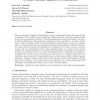Free Online Productivity Tools
i2Speak
i2Symbol
i2OCR
iTex2Img
iWeb2Print
iWeb2Shot
i2Type
iPdf2Split
iPdf2Merge
i2Bopomofo
i2Arabic
i2Style
i2Image
i2PDF
iLatex2Rtf
Sci2ools
109
Voted
JMLR
2002
2002
A Robust Minimax Approach to Classification
When constructing a classifier, the probability of correct classification of future data points should be maximized. We consider a binary classification problem where the mean and covariance matrix of each class are assumed to be known. No further assumptions are made with respect to the classconditional distributions. Misclassification probabilities are then controlled in a worst-case setting: that is, under all possible choices of class-conditional densities with given mean and covariance matrix, we minimize the worst-case (maximum) probability of misclassification of future data points. For a linear decision boundary, this desideratum is translated in a very direct way into a (convex) second order cone optimization problem, with complexity similar to a support vector machine problem. The minimax problem can be interpreted geometrically as minimizing the maximum of the Mahalanobis distances to the two classes. We address the issue of robustness with respect to estimation errors (in ...
Related Content
| Added | 22 Dec 2010 |
| Updated | 22 Dec 2010 |
| Type | Journal |
| Year | 2002 |
| Where | JMLR |
| Authors | Gert R. G. Lanckriet, Laurent El Ghaoui, Chiranjib Bhattacharyya, Michael I. Jordan |
Comments (0)

